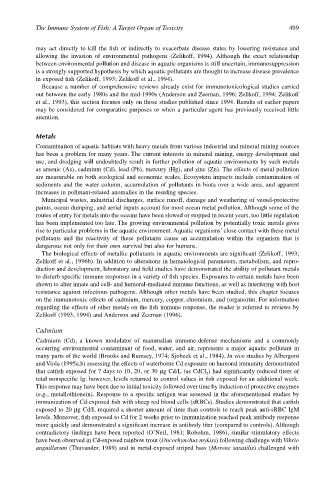Page 519 - The Toxicology of Fishes
P. 519
The Immune System of Fish: A Target Organ of Toxicity 499
may act directly to kill the fish or indirectly to exacerbate disease states by lowering resistance and
allowing the invasion of environmental pathogens (Zelikoff, 1994). Although the exact relationship
between environmental pollution and disease in aquatic organisms is still uncertain, immunosuppression
is a strongly supported hypothesis by which aquatic pollutants are thought to increase disease prevalence
in exposed fish (Zelikoff, 1993; Zelikoff et al., 1994).
Because a number of comprehensive reviews already exist for immunotoxicological studies carried
out between the early 1980s and the mid-1990s (Anderson and Zeeman, 1996; Zelikoff, 1994; Zelikoff
et al., 1993), this section focuses only on those studies published since 1994. Results of earlier papers
may be considered for comparative purposes or when a particular agent has previously received little
attention.
Metals
Contamination of aquatic habitats with heavy metals from various industrial and mineral mining sources
has been a problem for many years. The current interests in mineral mining, energy development and
use, and dredging will undoubtedly result in further pollution of aquatic environments by such metals
as arsenic (As), cadmium (Cd), lead (Pb), mercury (Hg), and zinc (Zn). The effects of metal pollution
are measurable on both ecological and economic scales. Ecosystem impacts include contamination of
sediments and the water column, accumulation of pollutants in biota over a wide area, and apparent
increases in pollutant-related anomalies in the residing species.
Municipal wastes, industrial discharges, surface runoff, damage and weathering of vessel-protective
paints, ocean dumping, and aerial inputs account for most ocean metal pollution. Although some of the
routes of entry for metals into the oceans have been slowed or stopped in recent years, too little regulation
has been implemented too late. The growing environmental pollution by potentially toxic metals gives
rise to particular problems in the aquatic environment. Aquatic organisms’ close contact with these metal
pollutants and the reactivity of these pollutants cause an accumulation within the organism that is
dangerous not only for their own survival but also for humans.
The biological effects of metallic pollutants in aquatic environments are significant (Zelikoff, 1993;
Zelikoff et al., 1996b). In addition to alterations in hematological parameters, metabolism, and repro-
duction and development, laboratory and field studies have demonstrated the ability of pollutant metals
to disturb specific immune responses in a variety of fish species. Exposures to certain metals have been
shown to alter innate and cell- and humoral-mediated immune functions, as well as interfering with host
resistance against infectious pathogens. Although other metals have been studied, this chapter focuses
on the immunotoxic effects of cadmium, mercury, copper, chromium, and (organo)tin. For information
regarding the effects of other metals on the fish immune response, the reader is referred to reviews by
Zelikoff (1993, 1994) and Anderson and Zeeman (1996).
Cadmium
Cadmium (Cd), a known modulator of mammalian immune-defense mechanisms and a commonly
occurring environmental contaminant of food, water, and air, represents a major aquatic pollutant in
many parts of the world (Brooks and Rumsey, 1974; Sjobeck et al., 1984). In vivo studies by Albergoni
and Viola (1995a,b) assessing the effects of waterborne Cd exposure on humoral immunity demonstrated
that catfish exposed for 7 days to 10, 20, or 30 µg Cd/L (as CdCl ) had significantly reduced titers of
2
total nonspecific Ig; however, levels returned to control values in fish exposed for an additional week.
This response may have been due to initial toxicity followed over time by induction of protective enzymes
(e.g., metallothionein). Response to a specific antigen was assessed in the aforementioned studies by
immunization of Cd-exposed fish with sheep red blood cells (sRBCs). Studies demonstrated that catfish
exposed to 20 µg Cd/L required a shorter amount of time than controls to reach peak anti-sRBC IgM
levels. Moreover, fish exposed to Cd for 2 weeks prior to immunization reached peak antibody response
more quickly and demonstrated a significant increase in antibody titer (compared to controls). Although
contradictory findings have been reported (O’Neil, 1981; Robohm, 1986), similar stimulatory effects
have been observed in Cd-exposed rainbow trout (Oncorhynchus mykiss) following challenge with Vibrio
anguillarum (Thuvander, 1989) and in metal-exposed striped bass (Morone saxatilis) challenged with

